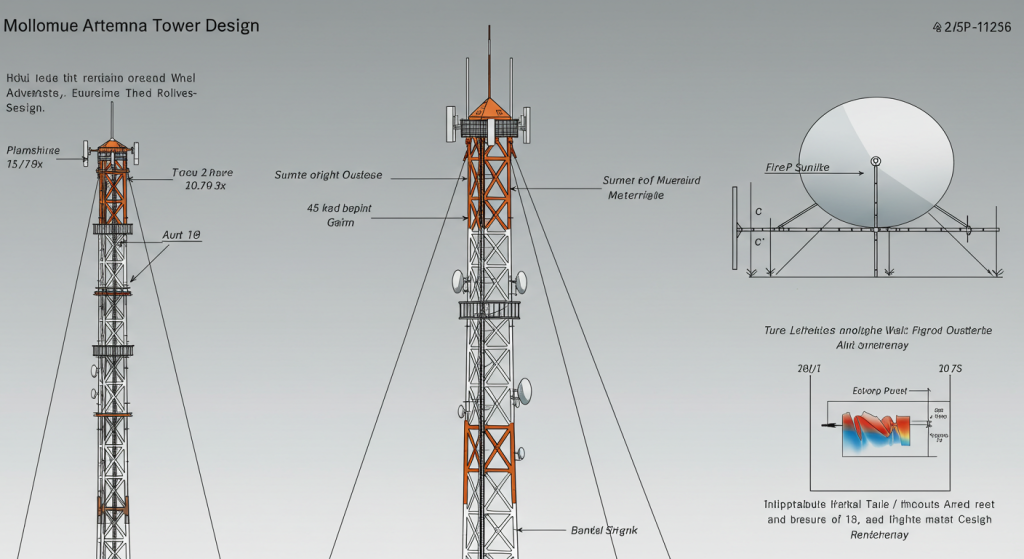Monopole Antenna Tower with Foundation Design: The Guide
2025-05-23
Modern monopole antenna tower with foundation design are growing in popularity for both rural and urban settings due to their sleek design and minimal spatial footprint. However, the success of these structures depends not only on the design features above the ground but, more importantly, on the foundation design. The possibility of an engineered foundational structure enables stability, safety, and longevity, which are essential for the towers, thus making it the bedrock of monopole tower projects.
Features of Monopole Antenna Towers
Monopole self-supporting antenna towers are vertically rising structures mounted on the ground. Featuring antennas and other communication equipment, these towers are made from steel for maximal durability. Their streamlined scaffolding makes them best suited for areas of space constraint or strong aesthetic concerns.
Key Features:
• Space Efficiency: These towers are suitable for urban areas, as, unlike other designs, they occupy very minimal ground area.
• Aesthetic Appeal: Compared to lattice towers, their slender profile makes them a more appealing option, as they do not dominate the skyline.
• Installation Simplicity: Prefabricated portions minimize the time for assembly and labor at the construction site.
Why Primary Research: Designing a Foundation for Monopole Antenna Towers is Engineers' Best Work?
- There is no doubt that the foundation is the most important part of a monopole antenna tower. It is the least visible component, but it works hand in hand with everything that is built above the ground. For example, the foundation has to keep the load of the tower on the earth vertically, while withstanding wind and seismic activity. Furthermore, a refined foundation is required, as having any form of a tower structure will leave the components susceptible, unstable, and unsafe.
- To a poorly managed foundation, a whole host of new problems are yielded, such as. The tower will tilt, leading to an unbalanced settlement, which will cause structural segregation, while others will experience complete failure. Furthermore, this is an extreme economic expense to the telecom equipment, but it is a relative endangerment and disruption of extremely important communication systems. So, the primary design cornerstone is without a doubt the tower’s foundation.
Design Considerations and Standards
Calculation of the required load poses no challenge, provided that accurate calculations are done. The following factors can be considered while making calculations:
• Dead Loads: the weight of the tower and the included equipment.
• Live Loads: loads that change over time, for example, maintenance workers.
• Environmental Loads: changes in temperature, wind, and seismic activities.
1. Wind Load Considerations
The wind poses a threat to tall structures. Regulations such as ANSI/TIA-222-H deal with proposals concerning estimations of wind load and other factors, such as:
• Geographical Location: Different areas correspond with differing wind speeds.
• Tower Height and Shape: Taller and broader structures are subjected to more wind pressure
• Exposure Category: Explains the impact of the terrain surrounding a site on the wind velocity.
2. Seismic Design
In seismic risk zones, foundation systems require careful configuration to support seismic forces. This encompasses:
• Analyzing the possibility of soil’s strength loss in a liquefied state during seismic activities.
• The employment of flexible joints capable of absorbing shock.
3. Corrosion Protection
To ensure durability:
• Material Selection: Using certain grades of steel having corrosion-resistant properties.
• Protective Coatings: A Specialized type of paint or hot-dip galvanized coating.
• Drainage design: Designing to avoid water drainage around the base.

Electric Monopole Design Parameters of Antenna Tower Monopole with Foundation Design
Site planning for the construction of an electric monopole antenna tower with foundation design entails considering a variety of parameters to design which ensure safety, durability, and efficiency. Performance parameters govern the structural strength as well as the electrical efficiency of the foundation and the tower.
1. Electric Monopole Pitch
Pitch is defined as the distance separating two adjacent monopoles. This spacing should be sufficient to guarantee structural stability as well as meet electromagnetic field conditions. Poor pitch could result in a great deal of electromagnetic interference and mechanical stress. Predominant ranges are pitched from 6 to 12 meters, depending on terrain and voltage level.
2. Voltage Level
The height and the clearance of the insulation are determined by the transmission voltage. Monopole towers as well as their foundations are subjected to greater electric and mechanical loads as the voltage increases at 132 kV, 220 kV, or even 500 kV.
3. Wire Specifications
The kind and size of the conductor (ACSR, AAAC), as well as tension (for example, 240 mm²), have an impact on the design of the tower. Vertically mounted conductors have a more dynamic load than horizontal ones, and because of this, they require reinforced base plates and stronger support arms.
4. Lightning Conductor Specifications
The lightning protection system is required to be grounded. A single spike or air terminal is usually mounted on the top of the floodlight and is connected to the foundation grounding network with down conductors.
5. Electric Monopole Height
Depending on the voltage level, location, and necessary clearance, the height varies from 15 meters to 45 meters. Monopole towers have to be mounted on the pile or deep-type foundations to make them stable against wind and seismic forces, thus increasing the height of the monopole.
Best Practices in Foundation Design
1. Comprehensive Site Surveys
No work on the foundation begins without a prior geotechnical survey. This entails the extraction of soil samples, the undertaking of borehole drilling, and varied laboratory tests to determine the bearing capacity, elevation of the water table, as well as soil settlement. Knowing the condition of the subsoil takes a great deal of the burden off the engineers in deciding the most suitable type of footing or foundation to use, be it spread footing, pile, or caisson. In the absence of this data, there exists a possibility of structural failure.
2. Compliance with Regulations
Every local geotechnical engineering standard must be reinforced by globally accepted codes such as TIA-222-H, along with building benchmarks applicable to the locality. The basic requirement of these standards is for the structure to withstand loads from wind, seismic activity, and dead weights. Following these codes guarantees the integrity of the structure throughout its lifespan.
3. Regular Inspections
Looking for cracks, tilts, and surface erosion is the first stage of documenting underway deterioration. These post-construction measures of inspecting the foundation enable engineers to ascertain its accuracy alongside the design calculations. Regular audits help catch minor problems before they bloom into severe issues, which might destabilize the tower.
4. Maintenance Plans
An effective strategy for preventive maintenance is essential. Regular checks for settlement, corrosion, and water pooling are some of the activities that can significantly increase the foundation’s lifespan. Routine maintenance guarantees the operational safety of monopole towers, particularly in harsh weather conditions.
Conclusion
Integral to the securing a monopole antenna tower with foundation design monitoring its parameters such as weight control, amount of force, damage, structural strain under critical usage, enabling superior range, work efficiency level adjacent antennae, as well as is a critical component is the foundation design where multiple elements comes into play: formwork, construction design, fail-proof, mounts, and hydraulic jacks, tailor subleveling. XY Tower holds further information regarding monopole tower solutions, designs of tower foundations.

Hey, I’m Chunjian Shu
"X.Y. Tower: Reliable, innovative solutions for high-quality towers and electrical equipment with professional service.
